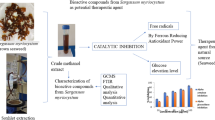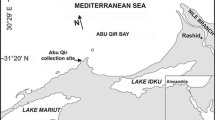Abstract
This study comprehensively presents the relationship between the bioactive substance of 70% (v/v) aqueous ethanol extract of 38 species of seaweeds (SWEs), and anti-glycation activities. The contents of bioactive substance of SWEs, such as total phenolic, total flavonoid and condensed tannins, were determined through a colorimetric analysis. Among the tested species, Ecklonia bicyclis, Ishige foliacea, and Cladophora urightiana var. minor had the highest amount of total phenolic (255.75 mg GAE/g DW), total condensed tannins (63.36 mg CE/g DW), and total flavonoid content (85.26 mg CE/g DW), respectively. Anti-glycation properties of SWEs were evaluated through advanced glycation end-products (AGEs) formation, AGEs-collagen cross-link formation, and AGEs-collagen cross-link breaking assay. Brown algae species exhibited a more prominent inhibitory activity on AGEs formation and AGEs-collagen cross-links, and the breaking of AGEs-collagen cross-links compared to that exhibited by aminoguanidine and ALT-711 (positive controls). Using principal component analysis, we confirmed that the AGEs formation inhibitory property and AGEs-collagen cross-links breaking activity were closely correlated with total phenolic and the condensed tannin contents contained in SWEs. Therefore, the bioactive substances such as phenolics and condensed tannins in seaweeds can be used as predictive indices in selecting compounds for the development of a therapeutic agent that prevents diabetic complications related to the AGEs. In addition, our results suggest that brown algae species, which contains more bioactive substances than green and red algae species, can be utilized as a promising natural resource for the prevention and alleviation of AGEs-related diabetic complications as AGE inhibitor and cross-links breaker.





Similar content being viewed by others
Data Availability
The data in this study are available from the corresponding author, upon reasonable request.
References
Rabbani N, Thornalley PJ (2018) Advanced glycation end products in the pathogenesis of chronic kidney disease. Kidney Int 93:803–813
Rowan S, Bejarano E, Taylor A (2018) Mechanistic targeting of advanced glycation end-products in age-related disease. BBA Mol Basis Dis 1864:3631–3643
Sourris KC, Harcourt BE, Forbes JM (2009) A new perspective on therapeutic inhibition of advanced glycation in diabetic microvascular complications: common downstream endpoints achieved through disparate therapeutic approaches? Am J Nephrol 30:323–335
Jud P, Sourij H (2019) Therapeutic options to reduce advanced glycation end products in patients with diabetes mellitus: a review. Diabetes Res Clin Pract 148:54–63
Edelstein D, Brownlee M (1992) Mechanistic studies of advanced glycosylation end product inhibition by aminoguanidine. Diabetes 41:26–29
Khalifah RG, Baynes HW, Hudson BG (1999) Amadorins: novel post-amadori inhibitors of advanced glycation reactions. Biochem Biophys Res Commun 257:251–258
Thornalley PJ (2003) Use of aminoguanidine (Pimagedine) to prevent the formation of advanced glycation endproducts. Arch Biochem Biophys 419:31–40
Anis MA, Sreerama YN (2020) Inhibition of protein glycoxidation and advanced glycation end-product formation by barnyard mille (Echinochloa frumentacea) phenolics. Food Chem 315:126265
Freedman BI, Wuerth J-P, Cartwright K, Bain RP, Dippe S, Spinowitz BS (1999) Design and baseline characteristics for the aminoguanidine clinical trial in overt type 2 diabetic nephropathy (ACTION II). Control Clin Trials 20:493–510
Sharifuddin Y, Chin Y-X, Lim P-E, Phang S-M (2015) Potential bioactive compounds from seaweed for diabetes management. Mar Drugs 13:5447–5491
Mohamed S, Hashim SN, Rahman HA (2012) Seaweeds: a sustainable functional food for complementary and alternative therapy. Trends Food Sci Technol 23:83–96
Venkatraman KL, Mehta A (2019) Health benefits and pharmacological effects of Porphyra species. Plant Foods Hum Nutr 74:10–17
Anwar S, Khan S, Almatroudi A, Khan AA, Alsahli MA, Almatroodi SA et al (2021) A review on mechanism of inhibition of advanced glycation end products formation by plant derived polyphenolic compounds. Mol Biol Rep 48:787–805
Do MH, Hur J, Choi J, Kim M, Kim MJ, Kim Y et al (2018) Eucommia ulmoides Ameliorates glucotoxicity by suppressing advanced glycation end-products in diabetic mice kidney. Nutrients 10:E265
Mestry SN, Gawali NB, Gursahani MS, Pai SA, Dhodi JB, Juvekar AR (2018) Inhibition of advanced glycation end products by Punica granatum Linn. leaves and its antioxidant activity. Orient Pharm Exp Med 18:97–105
Chen Y, Tang S, Chen Y, Zhang R, Zhou M, Wang C et al (2019) Structure-activity relationship of procyanidins on advanced glycation end produts formation and corresponding mechanisms. Food Chem 272:679–687
Thomas NV, Kim S-K (2011) Potential pharmacological applications of polyphenolic derivative from marine brown algae. Environ Toxicol Pharmacol 32:325–335
Jimenez-Lopez C, Pereira AG, Lourenco-Lopes C, Garcia-Oliveira P, Cassani L, Fraga-Corral M et al (2021) Main bioactive phenolic compounds in marine algae and their mechanisms of action supporting potential health benefits. Food Chem 341:128262
Kim T-H, Ko S-C, Oh G-W, Park H-H, Lee D-S, Yim M-J et al (2016) Studies on bioactive substances and antioxidant activities of marine algae from Jeju Island. J Mar Biotechnol 8:30–38
Lee C-H, Park YN, Lee SG (2020) Analysis and comparison of bioactive compounds and total antioxidant capabilities of Korean brown algae. Korean Soc Food Sci Technol 52:54–59
Yangthong M, Hutadilok-Towatana N, Phromkunthong W (2009) Antioxidant activities of four edible seaweeds from the southern coast of Thailand. Plant Foods Hum Nutr 64:218–223
Harcha PSCS, Gardana C, Simonetti P, Spigno G, Levelli V (2013) Characterization of phenolics, in vitro reducing capacity and anti-glycation activity of red grape skins recovered from winemaking by-products. Bioresour Technol 140:263–268
Ou-Yang C, Chai W, Xu X, Song S, Wei Q, Huang Q et al (2020) Inhibitory potential of proanthocyanidins from the fruit pulp of Clausena lansium (Lour.) skeels against α-glucosidase and non-enzymatic glycation:activity and mechanism. Process Biochem 91:364–373
Khan M, Liu H, Wang J, Sun B (2020) Inhibitory effect of phenolic compounds and plant extracts on the formation of advance glycation end products: a comprehensive review. Food Res Int 130:108933
Kuda T, Eda M, Kataoka M, Nemoto M, Kawahara M, Oshio S et al (2016) Anti-glycation properties of the aqueous extract solutions of dried algae products and effect of lactic acid fermentation on the properties. Food Chem 192:1109–1115
Jung HA, Yoon NY, Woo M-H, Choi GS (2008) Inhibitory activities of extracts from several kinds of seaweeds and phlorotannins from the brown alga Ecklonia stolonifera on glucose-mediated protein damage and rat lens aldose reductase. Fish Sci 74:1363–1365
Thomas MC, Baynes JW, Thorpe SR, Cooper ME (2005) The role of AGes and AGE inhibitors in diabetic cardiovascular disease. Curr Drug Targets 6:453–474
Knott HM, Brown BE, Davies MJ, Dean RT (2003) Glycation and glycoxidation of low-density lipoproteins by glucose and low-molecular mass aldehydes. Eur J Biochem 270:3572–3582
Shakambari G, Ashokkumar B, Varalakshmi P (2015) Phlorotannins from brown algae: inhibition of advanced glycation end products formation in high glucose induced Caenorhabditis elegans. Indian J Exp Biol 53:371–379
Funding
This research was supported by Main Research Program (E0164400-05) of the Korea Food Research Institute and National Research Foundation of Korea (NRF) grant funded by the Korea government (MSIT, NRF-2020R1A2C2012608).
Author information
Authors and Affiliations
Corresponding author
Ethics declarations
Conflict of Interest
The authors declare that there are no competing interests associated with this publication.
Additional information
Publisher’s Note
Springer Nature remains neutral with regard to jurisdictional claims in published maps and institutional affiliations.
Supplementary Information
Below is the link to the electronic supplementary material.
Rights and permissions
About this article
Cite this article
Cho, C.H., Youm, G.H., Kim, M. et al. Evaluation of the Relationship Between Bioactive Components in Seaweeds and Advanced Glycation End-Products Inhibitory Activities Using Principal Component Analysis. Plant Foods Hum Nutr 76, 326–333 (2021). https://doi.org/10.1007/s11130-021-00908-5
Accepted:
Published:
Issue Date:
DOI: https://doi.org/10.1007/s11130-021-00908-5




